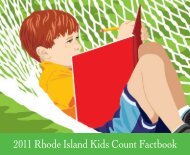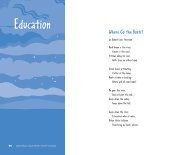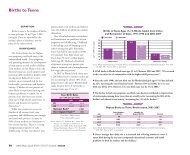2010 Rhode Island Kids Count Factbook
2010 Rhode Island Kids Count Factbook
2010 Rhode Island Kids Count Factbook
You also want an ePaper? Increase the reach of your titles
YUMPU automatically turns print PDFs into web optimized ePapers that Google loves.
Racial and Ethnic Diversity<br />
Children Living Below<br />
the Poverty Threshold<br />
Children Living With Families<br />
Spending More Than 30% of<br />
Family Income on Housing<br />
15%<br />
17%<br />
42%<br />
56%<br />
Children Whose Parents<br />
Both Have Less Than a High<br />
School Degree<br />
6%<br />
23%<br />
DEFINITION<br />
Racial and ethnic diversity is the<br />
percentage of children under age 18 by<br />
racial and ethnic categories as defined<br />
by the 2000 U.S. Census. Racial and<br />
ethnic categories are chosen by the head<br />
of household or person completing the<br />
Census form.<br />
SIGNIFICANCE<br />
Racial and ethnic diversity has<br />
increased in the United States over the<br />
last several decades and is projected to<br />
rise in the future. 1 Minority children<br />
(all those except White, non-Hispanic<br />
children) accounted for 98% of the<br />
growth in the U.S. child population<br />
during the 1990s. 2 In 2008, 56% of<br />
all U.S. children were White non-<br />
Hispanic. 3 According to Census Bureau<br />
projections, the U.S. is becoming more<br />
racially and ethnically diverse. By 2030<br />
more than half of all children in the<br />
United States will be children of color. 4<br />
In 2000, 73% of children in <strong>Rhode</strong><br />
<strong>Island</strong> were White, non-Hispanic, down<br />
from 84% in 1990. The number of<br />
minority children nearly doubled from<br />
about 37,000 in 1990 to about 68,000<br />
in 2000. The number of White non-<br />
Hispanic children dropped by nearly<br />
9,000 during the same period. 5,6<br />
Between 2006 and 2008 in <strong>Rhode</strong><br />
<strong>Island</strong>, 74% of children under age 18<br />
were White, 7% were Black or African<br />
American, 3% were Asian, 1% were<br />
Native American, 11% of children were<br />
identified as "some other race," and 4%<br />
as two or more races. Between 2006<br />
and 2008, 19% of children living in<br />
<strong>Rhode</strong> <strong>Island</strong> were Hispanic. 7<br />
Minority children are concentrated<br />
in <strong>Rhode</strong> <strong>Island</strong>'s six core cities. Core<br />
cities are defined as cities in which 15%<br />
or more of the children live in poverty.<br />
More than half (58%) of children living<br />
in the core cities are minority children.<br />
More than three-quarters (78%) of all<br />
minority children in <strong>Rhode</strong> <strong>Island</strong> live<br />
in these six communities. 8<br />
Between 2006 and 2008, there were<br />
9,301 foreign-born children living in<br />
<strong>Rhode</strong> <strong>Island</strong>, 25% of whom were<br />
naturalized U.S. citizens. 9 Of <strong>Rhode</strong><br />
<strong>Island</strong>’s immigrant children, 28% were<br />
born in Central or South America, 21%<br />
were born in the Caribbean, 16% were<br />
born in Africa, 14% were born in Asia,<br />
13% were born in Europe, and 7%<br />
were born in North America (Canada,<br />
Bermuda or Mexico). 10<br />
Between 2006 and 2008, 22% of<br />
children ages five to 17 living in <strong>Rhode</strong><br />
<strong>Island</strong> spoke a language other than<br />
English at home, 93% of whom spoke<br />
English well or very well. 11<br />
Diversity presents both opportunities<br />
and challenges to schools, child care<br />
centers, health care providers, social<br />
service agencies and other community<br />
service providers, in terms of adapting<br />
current practices to meet the needs of a<br />
changing population. 12<br />
Children with No Employed<br />
Resident Parents<br />
Characteristics of Children Living<br />
37%<br />
in Immigrant and<br />
Non-immigrant Families, <strong>Rhode</strong> <strong>Island</strong>, 2008<br />
Children Living in<br />
Single-Parent Families<br />
Children Living Below<br />
the Poverty Threshold<br />
Children Living in<br />
Crowded Housing<br />
Children Whose Parents<br />
All Have Less Than a<br />
High School Degree<br />
Children in Families Without<br />
Secure Parental Employment<br />
10%<br />
9%<br />
31%<br />
Children in Non-immigrant Families<br />
0% 10% 20% 30% 40% 50%<br />
Children in Immigrant Families<br />
4%<br />
13%<br />
8%<br />
14%<br />
19%<br />
20%<br />
34%<br />
32%<br />
0% 10% 20% 30% 40% 50%<br />
Source: The Annie E. Casey Foundation KIDS COUNT Data Center. Retrieved February 4, <strong>2010</strong> from<br />
www.kidscount.org/datacenter<br />
60% 70% 80% 90% 100%<br />
60% 70% 80% 90% 100%<br />
◆ Twenty-four percent of children in <strong>Rhode</strong> <strong>Island</strong> live in immigrant families (either<br />
they are foreign-born or they have at least one parent who is foreign-born), similar to the<br />
U.S. rate of 23%. 13 Most immigrant families in <strong>Rhode</strong> <strong>Island</strong> are not new arrivals to the<br />
United States; 1% of children in <strong>Rhode</strong> <strong>Island</strong> immigrant families have parents who<br />
arrived in this country fewer than five years ago. 14 Ninety-six percent of children in<br />
<strong>Rhode</strong> <strong>Island</strong> were born in the United States. 15<br />
◆ Fourteen percent of children in <strong>Rhode</strong> <strong>Island</strong> in non-immigrant families are poor,<br />
compared with 19% of children in immigrant families. 16 More than two-thirds (69%) of<br />
<strong>Rhode</strong> <strong>Island</strong>’s poor children live in families with U.S.-born parents. 17<br />
◆ The social and economic well-being of immigrant children is influenced by their<br />
parents’ proficiency in English. Limited English proficiency can be a barrier to<br />
employment opportunities, higher earnings, access to health care and parental<br />
engagement in schools. 18 Twenty-one percent of children in immigrant families in <strong>Rhode</strong><br />
<strong>Island</strong> live in linguistically-isolated households, meaning no one over age 14 either<br />
speaks only English or speaks English "very well." 19<br />
18 <strong>2010</strong> <strong>Rhode</strong> <strong>Island</strong> KIDS COUNT <strong>Factbook</strong> / Family and Community






